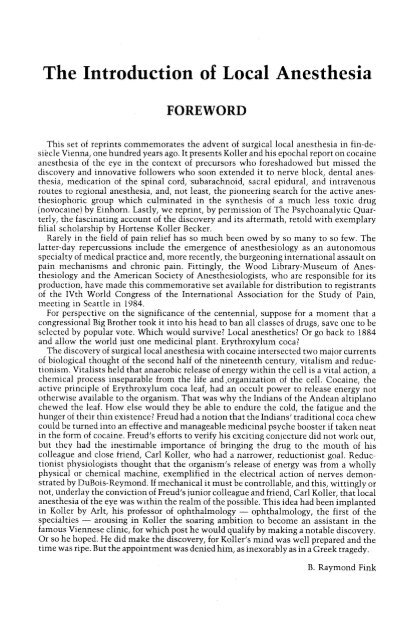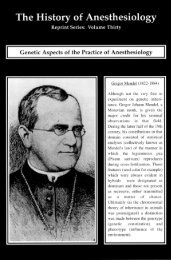Download PDF - Wood Library-Museum of Anesthesiology
Download PDF - Wood Library-Museum of Anesthesiology
Download PDF - Wood Library-Museum of Anesthesiology
You also want an ePaper? Increase the reach of your titles
YUMPU automatically turns print PDFs into web optimized ePapers that Google loves.
The Introduction <strong>of</strong> Local AnesthesiaFOREWORDThis set <strong>of</strong> reprints commemorates the advent <strong>of</strong> surgical local anesthesia in fin-desiecleVienna, one hundred years ago. It presents Roller and his epochal report on cocaineanesthesia <strong>of</strong> the eye in the context <strong>of</strong> precursors who foreshadowed but missed thediscovery and innovative followers who soon extended it to nerve block, dental anesthesia,medication <strong>of</strong> the spinal cord, subarachnoid, sacral epidural, and intravenousroutes to regional anesthesia, and, not least, the pioneering search for the active anesthesiophoricgroup which culminated in the synthesis <strong>of</strong> a much less toxic drug(novocaine) by Einhorn. Lastly, we reprint, by permission <strong>of</strong> The Psychoanalytic Quarterly,the fascinating account <strong>of</strong> the discovery and its aftermath, retold with exemplaryfilial scholarship by Hortense Roller Becker.Rarely in the field <strong>of</strong> pain relief has so much been owed by so many to so few. Thelatter-day repercussions include the emergence <strong>of</strong> anesthesiology as an autonomousspecialty <strong>of</strong> medical practice and, more recently, the burgeoning international assault onpain mechanisms and chronic pain. Fittingly, the <strong>Wood</strong> <strong>Library</strong>-<strong>Museum</strong> <strong>of</strong> <strong>Anesthesiology</strong>and the American Society <strong>of</strong> Anesthesiologists, who are responsible for itsproduction, have made this commemorative set available for distribution to registrants<strong>of</strong> the IVth World Congress <strong>of</strong> the International Association for the Study <strong>of</strong> Pain,meeting in Seattle in 1984.For perspective on the significance <strong>of</strong> -the centennial, suppose for a moment that acongressional Big Brother took it into his head to ban all classes <strong>of</strong> drugs, save one to beselected by popular vote. Which would survive? Local anesthetics? Or go back to 1884and allow the world just one medicinal plant. Erythroxylum coca?The discovery <strong>of</strong> surgical local anesthesia with cocaine intersected two major currents<strong>of</strong> biological thought <strong>of</strong> the second half <strong>of</strong> the nineteenth century, vitalism and reductionism.Vitalists held that anaerobic release <strong>of</strong> energy within the cell is a vital action, achemical process inseparable from the life and .organization <strong>of</strong> the cell. Cocaine, theactive principle <strong>of</strong> Erythroxylum coca leaf, had an occult power to release energy nototherwise available to the organism. That was why the Indians <strong>of</strong> the Andean altiplanochewed the leaf. How else would they be able to endure the cold, the fatigue and thehunger <strong>of</strong> their thin existence? Freud had a notion that the Indians' traditional coca chewcould be turned into an effective and manageable medicinal psyche booster if taken neatin the form <strong>of</strong> cocaine. Freud's efforts to verify his exciting conjecture did not work out,but they had the inestimable importance <strong>of</strong> bringing the drug to the mouth <strong>of</strong> hiscolleague and close friend, Carl Roller, who had a narrower, reductionist goal. Reductionistphysiologists thought that the organism's release <strong>of</strong> energy was from a whollyphysical or chemical machine, exemplified in the electrical action <strong>of</strong> nerves demonstratedby DuBois-Reymond. If mechanical it must be controllable, and this, wittingly ornot, underlay the conviction <strong>of</strong> Freud's junior colleague and friend, Carl Roller, that localanesthesia <strong>of</strong> the eye was within the realm <strong>of</strong> the possible. This idea had been implantedin Roller by Arlt, his pr<strong>of</strong>essor <strong>of</strong> ophthalmology — ophthalmology, the first <strong>of</strong> thespecialties — arousing in Roller the soaring ambition to become an assistant in thefamous Viennese clinic, for which post he would qualify by making a notable discovery.Or so he hoped. He did make the discovery, for Roller's mind was well prepared and thetime was ripe. But the appointment was denied him, as inexorably as in a Greek tragedy.B. Raymond Fink
















